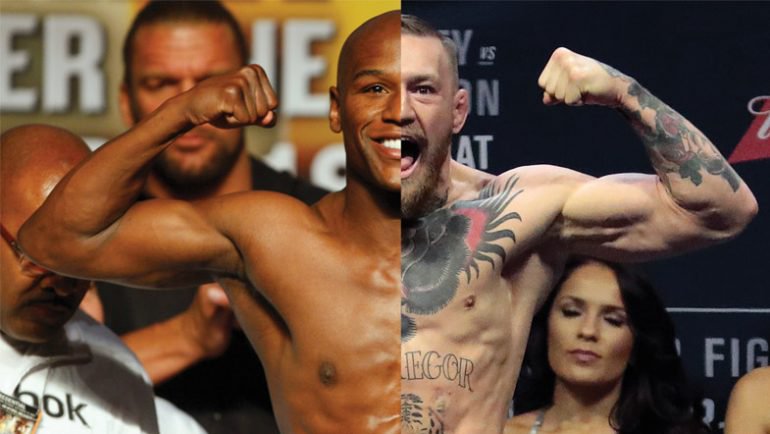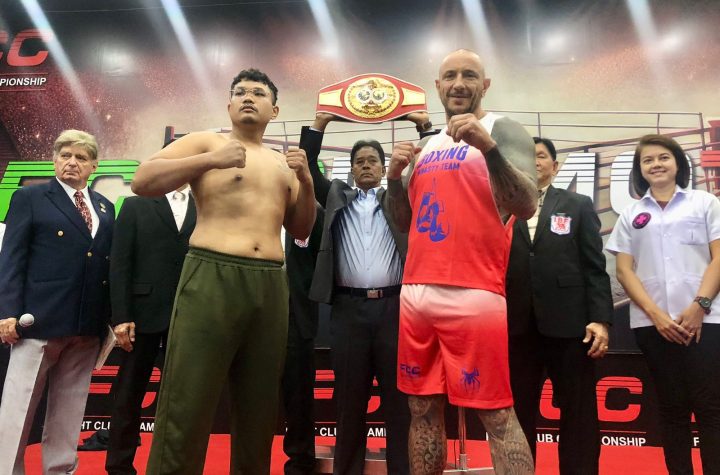

Note: This feature originally appeared in the August 2017 issue of THE RING Magazine
Most boxing writers and a good portion of the fans are cynical by nature, and nothing brings out their cynicism like Floyd Mayweather Jr. He’s like a B-12 shot for cynics, giving them more energy to gripe. So it’s no wonder people are jumping on him for preserving one of boxing’s oldest rituals – the farce bout.
Mayweather has been inching up to a showdown with UFC star Conor McGregor with the patience of a python sneaking up on a tasty rodent. And McGregor, a worthy dance partner for Mayweather in terms of having a big mouth and closets full of expensive clothing, has done his share to churn up interest in such a meeting. One almost wishes McGregor, who did some boxing in his teen years as part of an Irish youth league, had pursued the sweet science just so we could have his dynamic presence in our own rings. However, McGregor hasn’t looked impressive in the footage we’ve seen of him sparring. Some very fine and experienced fighters have faced Mayweather and couldn’t touch him; a guy who has never boxed professionally isn’t going to touch him either.
Still, the bout will attract not one, but two fan bases. Potentially, the numbers could be huge. Mayweather can again brag about being a pay-per-view phenomenon, forgetting that his feisty red-haired rival had something to do with it. The cynics will mention that Mayweather always forgets that his most impressive pay-per-view tallies were against popular fighters who drew the lion’s share of the buys. The cynics will also grumble that this is no different than when Mayweather took part in WrestleMania XXIV, or that he should be fighting a more deserving opponent. But they’d be missing the point. Mayweather didn’t invent the farce bout, any more than he invented gold jewelry. For as long as there have been great boxers with egos to feed and wannabes willing to be punched in the head, there have been absurdities like Mayweather-McGregor. The formula, which goes back 100 years or so, usually involves a ripened former champion against an inexperienced pug with just enough mystery about him to keep the suckers wondering.
Muhammad Ali was the farce master. After his first loss to Joe Frazier in 1971, he immediately started negotiating to fight NBA star Wilt Chamberlain that summer at the Houston Astrodome. The bout was on the verge of being signed when Chamberlain balked. Promoter Bob Arum went on record years later saying that Ali, who shouted “Timber!” every time he saw Chamberlain, had intimidated the basketball player. No matter. Ali would go on to have the ultimate farce bout in Tokyo against Antonio Inoki, a professional wrestler with a background in martial arts. Ali had been interested in fighting in Japan, but there were no Japanese heavyweights. When Inoki’s promotional company came forward with an offer, Ali agreed. Why not? He’d always been a wrestling fan.
The circumstances in Ali’s career at the time he fought Inoki cast light on all farce bouts. The watershed years of 1974-75 were behind him; in ’76 he was tired, showing his age. He needed something that was more showbiz than boxing, just to keep his name in the headlines. In Inoki he had the right opponent. Or so Ali thought. The bout, held at the celebrated Budokan Hall, turned out to be a boring mess. Inoki scuttled around the ring like a crab while Ali called him rude names, the likes of which these days would get him banned from social media. Worse, Inoki landed several kicks on Ali’s thighs; the resulting bruises and swelling sent Ali to the hospital. The “fight,” a 15-round stinker, was declared a draw.

Ali (left) attempts to evade kicks from wrestler Antonio Inoki. Photo by AP
After the bout, a sheepish Ali faced the press. “Inoki didn’t stand up and fight like a man,” Ali told The New York Times. “If he had gotten into hittin’ range, I’da burned him but good.” The irony was that many opponents had said similar things about Ali. Now Ali knew how it felt to be Jerry Quarry, which may have been the only thing he learned during his bout with a wrestler. Ali got his name in the news, as he always did, but the reviews were harsh.
It could be that Ali had heard stories about a 1963 bout pitting Archie Moore against a wrestler named Mike DiBiase. In front of a scrubby crowd in Phoenix, Moore won by TKO 20 seconds into the third round. It was Moore’s 219th professional bout. It was DiBiase’s first.
Moore was hoping his farce would lead to better things. He was 50, broke, and wanted to fight a contender. It never happened. Instead, Moore finished his career against DiBiase. As one San Diego sports columnist summed it up, Moore was “shedding all semblance of dignity by doing a carnival routine for a Phoenix wrestling promoter.”
Phoenix, incidentally, was where Roy Jones Jr. Enjoyed his own farce of a bout. Will Jones ever live down his 2016 encounter with Vyron Phillips? A former MMA fighter with a smidgeon of amateur boxing experience, Phillips was chosen in an online vote to be Jones’ opponent and guaranteed $100,000 if he could knock Jones out. Though Phillips entered the ring like a kid at the carnival ready to try the old “Test Your Strength” gimmick with a sledgehammer, Jones stopped him at 2:30 of Round 2. A farce, to be sure, but who is to say it wasn’t a confidence booster for Jones? Just a few months earlier he’d been violently KO’d in Russia by Enzo Maccarinelli. Sometimes a fighter, even a future Hall of Famer, likes an easy win.
Maybe Jack Johnson was simply looking for an easy one in 1916 when he strolled into a Barcelona bullring to face an unknown commodity named Arthur Cravan.
Johnson had lost the heavyweight championship the year before and, partying heavily and nearing 40, wasn’t in any condition to face a real fighter. A poet and magazine publisher who fancied himself a tough guy – he’d done some amateur boxing and had cheekily declared himself the “champion of Switzerland” – Cravan was a spotlight-whore who basically talked his way into the fight.
Johnson toyed with Cravan for five rounds before loosening up in the sixth. After Johnson landed a right described by one observer as “a blow worthy of a slaughterhouse,” Cravan crumbled and was counted out. Later, he allegedly became friends with Johnson. Maybe that had been Cravan’s wish all along, though he certainly went about it the hard way.
Not all farce bouts involve older fighters trying to make a quick buck against a beginner. Floyd Patterson’s management thought they had an easy mark in Pete Rademacher, an Olympic champion who made his pro debut by challenging for Patterson’s heavyweight title. Patterson, often chided for his camp’s delicate approach to matchmaking, heard much grief from the press for taking on a man who’d never fought professionally. Still, the pairing of amateur vs. professional drew 16,961 to Sick’s Stadium in Seattle on August 22, 1957. And in the second round, Rademacher electrified the crowd by putting Patterson on his ass. Of course, Patterson got up and proceeded to knock Rademacher all over the ring until the fight was finally halted at 2:57 of the sixth.
Patterson was a rarity in that his farce bout came early in his career. Most of the time, the farces come when the fighter has lost the shine of youth and just wants to fight somebody, anybody, who will fall easily. As bullying and manipulative as a politician rigging his own election, he’ll approach his farce as if it were a life-and-death battle, a return to past glories. From this we gather that even if there’s a stench around it, the thrill of victory is nice to revisit.
After losing most of his money in the stock market crash of 1929 and a divorce from actress Estelle Taylor, Jack Dempsey hit the exhibition trail in 1931. He took on local boxers across America in three and four round bouts. He also hired himself out as a referee, often in wrestling shows. The culmination of Dempsey’s post-career activities was a July 1, 1940, promotion in Atlanta that involved Dempsey against a pudgy wrestler named Clarence “Cowboy” Luttrell. With THE RING’s founder, Nat Fleischer, serving as referee, and approximately 10,000 in attendance, Dempsey stopped Luttrell at 1:58 of the second round. No one took the event too seriously, though newspapers gave it big-time coverage with headlines an inch high. Some sources, including Dempsey’s 1977 memoir, list it as Dempsey’s last official bout.
After Luttrell, Dempsey took on a few more wrestlers, including Ellis Bashara, a former football lineman who had wrestled as “The Purple Flash.” Why did Dempsey, one of America’s great sports icons, bother with such bogus events? Some suggested he was angling for a bout with reigning heavyweight champion Joe Louis. Though several in the press enjoyed seeing Dempsey again, many didn’t. The Chicago Tribune’s Stewart Owen wrote that seeing Dempsey in these debacles was like seeing the great horse, Man o’ War, “hitched to a garbage wagon.” Dempsey explained his motivation to Newsweek’s John Lardner. “I like putting a little money in my pocket,” Dempsey said, “and I enjoy the action.”
It was also a chance to show that his starpower hadn’t entirely waned. Good-sized crowds paid to see Dempsey dust off these pretend palookas. Happy just to see him uncork the old left hook, they probably didn’t ask for their money back.

Mayweather (right) tags Andre Berto in his most recent fight. Photo by Naoki Fukuda
Mayweather never mentions it, but he was probably stung that his final bout, a snoozer against Andre Berto in 2015, generated only mild interest. Even with Mayweather loudly declaring it would be his farewell, the public response was tepid. It’s not like he was Ted Williams taking his final swings at Fenway, with John Updike writing about it for The New Yorker. Mayweather isn’t that kind of sports figure. He just isn’t. But he likes numbers, and in McGregor he’s found someone who can help him surpass the less than a half-million buys he did with Berto. This time, Mayweather can sail into retirement on the wings of a big event. Also, don’t discount the fact that when he leaves the ring that night he’ll likely be 50-0. Again, he likes numbers.
McGregor is certainly many notches above the usual challengers drafted for farce bouts, but there is in Mayweather something of Ali looking for a way to keep his name in the news. And there’s something of Jack Johnson and Archie Moore, past their primes, wanting to win without risking much. There’s really nothing wrong with what Mayweather is doing. Great fighters have done it before him. He’ll soak in some big-fight atmosphere and once again give his critics reason to complain. Unlike Dempsey, he won’t have to bring his act all around the country. Thanks to the pay-per-view age, he need only do it once. But like the old Manassa Mauler, Mayweather will put a little money in his pocket and enjoy the action.





More News
IBF Asia Heavyweight Title Fight: Bisutti vs. Nattapong
Liu Gang, Brico Santig Join Forces
Highland’s Double Impact: August 18 at Lumpinee